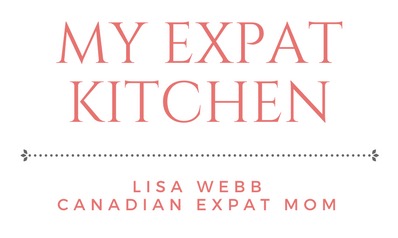
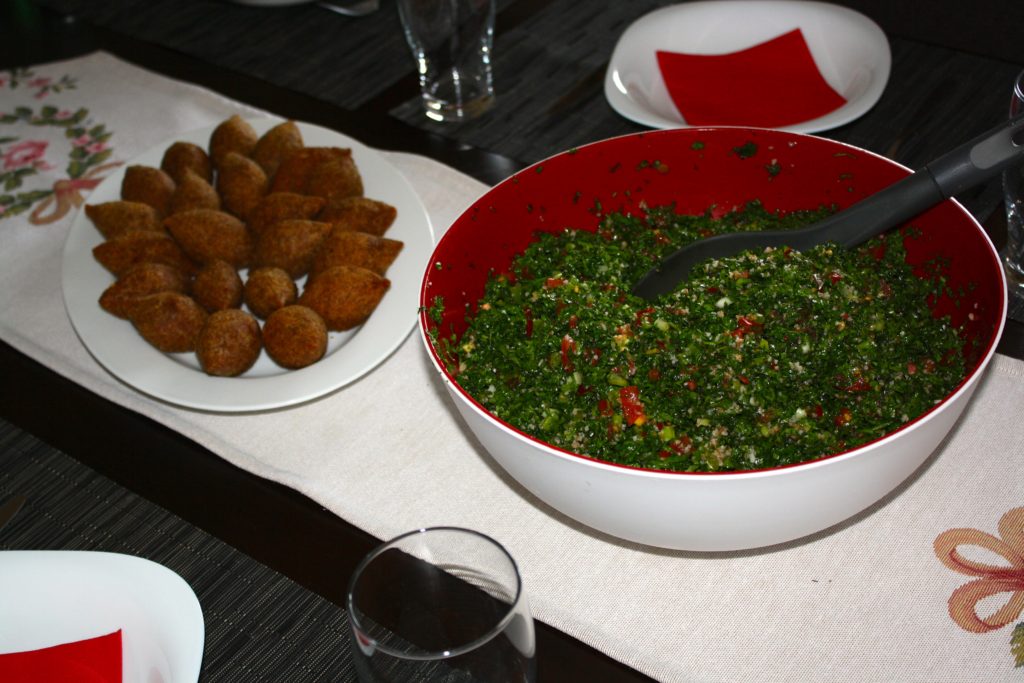 Often times, when you hear of a country, your mind goes directly to one thing.
Often times, when you hear of a country, your mind goes directly to one thing.
Paris-Eiffel Tower
Italy-pasta
Russia-cold
Unfortunately, when someone says Syria, for many people, their mind goes to the political unrest that has been in the news in recent years. My mind was the same until I found a new, more pleasant Syrian connection…my friend Hadeel.
We’ve all heard about Syrian refuges having to flee their country, but I never actually knew anyone from Syria until I met Hadeel here in Congo. The two of us are often at the same international activities, but we’d never really had much one-on-one conversation until the day we were in the salon at the same time.
Living in a small town in West Africa has a way of instantly bonding foreigners because we can quickly connect on the challenges and/or benefits of our location… and also, we usually stand out in a crowd.
“You’re from Canada,” she said to me that day in the salon. Then she continued with a smile, “There are lots of Syrians in Canada.”
I had a moment of national pride for being from a country where diversity is our strength and immigration is part of the patchwork that makes up our country.
Hadeel told me she had a lot of Syrian friends who were in Canada, and she might even hope to end up there herself one day too. But for now she’s with me in Congo, and has been here for 2.5 years. Before West Africa, Hadeel and her husband were living in Iraq, so she’s already earned a few expat stripes.
Hadeel is starting her own business making Syrian food here in Pointe-Noire, so I felt lucky to have her cook with me before she’s too busy cooking for everyone else in town. I can tell you first hand that her food is delicious, so if you’re in Pointe-Noire, check out her Facebook Page, Hadeel’s Kitchen and give it a taste for yourself!
Syrian Cooking in Africa With Hadeel 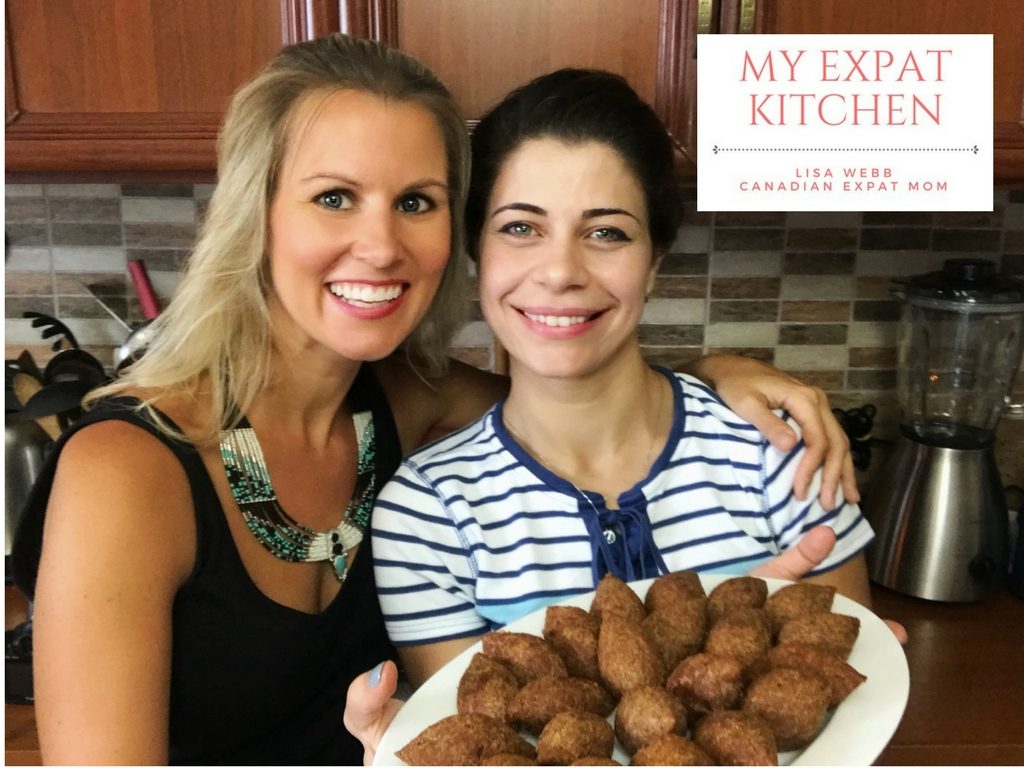 Kebbeh and Tabbouleh
Kebbeh and Tabbouleh
When I arrived at Hadeel’s she had already done some prep work before I got there.
She had rinsed the bulgur three times and had it in a bowl. The bulgur was soaking in water, with the secret ingredient– orange peel and onion, for flavour, as well as cumin, paprika, salt and pepper. You can also add lemon peel, marjoram or basil, depending on your preference.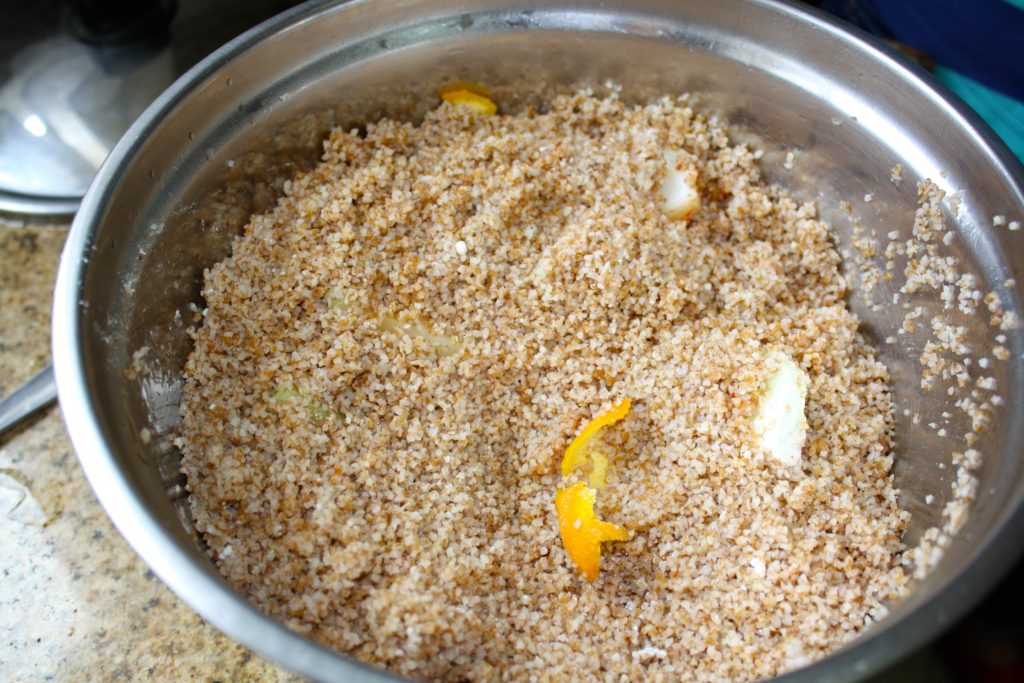
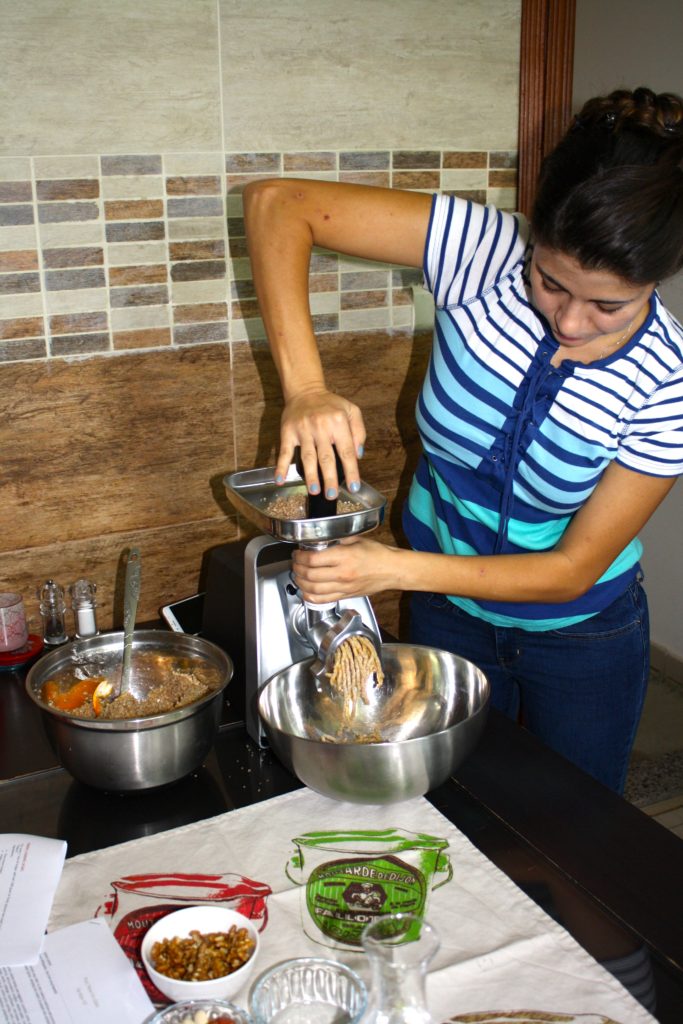 Put the bulgur mixture through a meat grinder; orange peel and all.It’ll end up looking like this.
Put the bulgur mixture through a meat grinder; orange peel and all.It’ll end up looking like this.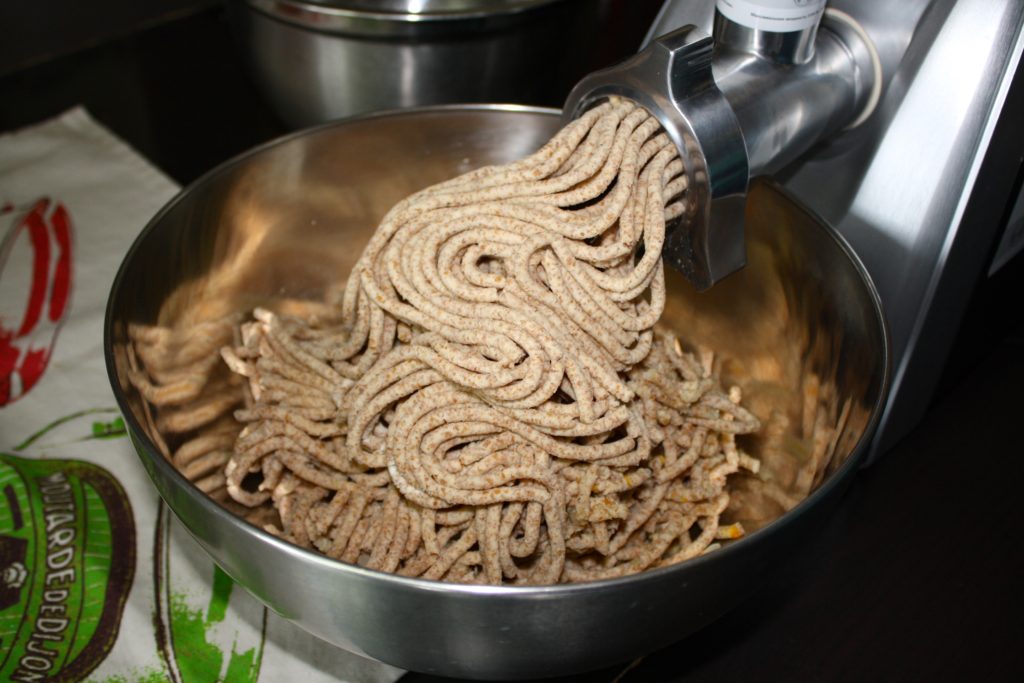 Add 500 grams of extra lean ground beef for every kilo of bulgur.
Add 500 grams of extra lean ground beef for every kilo of bulgur. 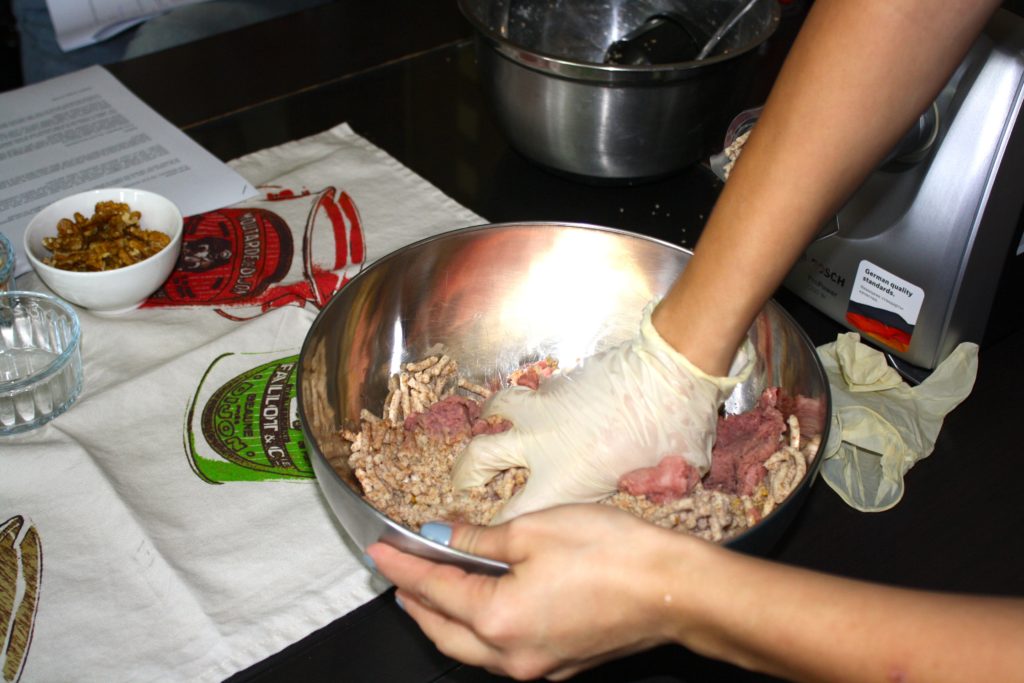 Mix the ground beef with the bulgur mixture and put it through the meat grinder again.
Mix the ground beef with the bulgur mixture and put it through the meat grinder again.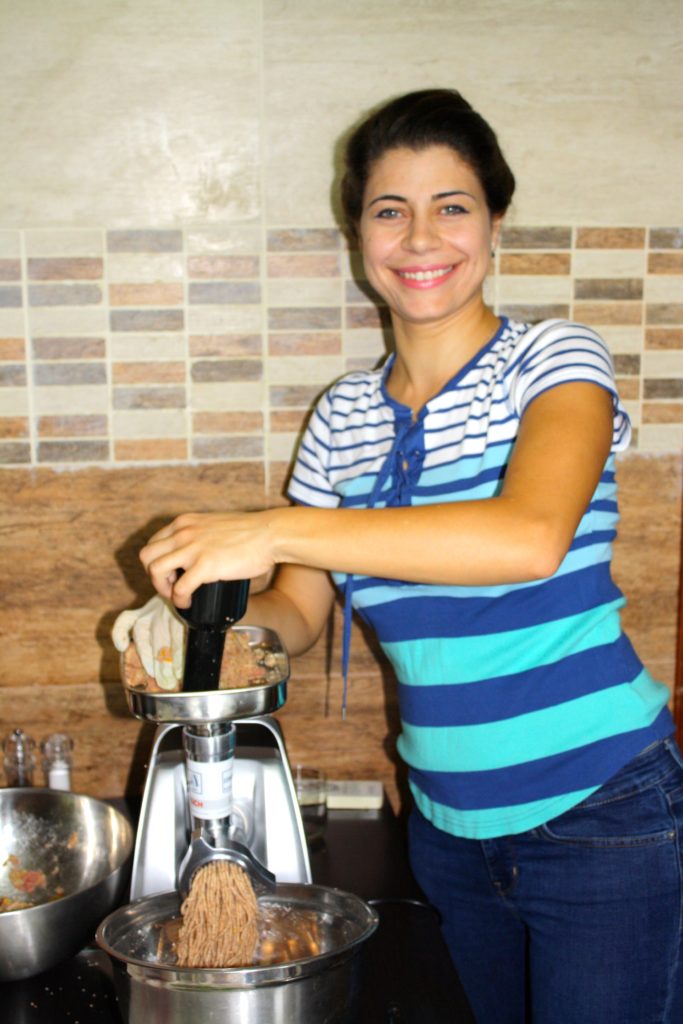 This mixture will become the outside of your kebbeh. Yes, there’s meat in the crust part…who knew!? Leave that to the side for a minute and we’ll work on the filling.
This mixture will become the outside of your kebbeh. Yes, there’s meat in the crust part…who knew!? Leave that to the side for a minute and we’ll work on the filling.
Finely mince some onions, or put it in the food processor. Then add them to a pot on medium heat with a tablespoon of ghee butter. But not too much ghee or it will break down the dough.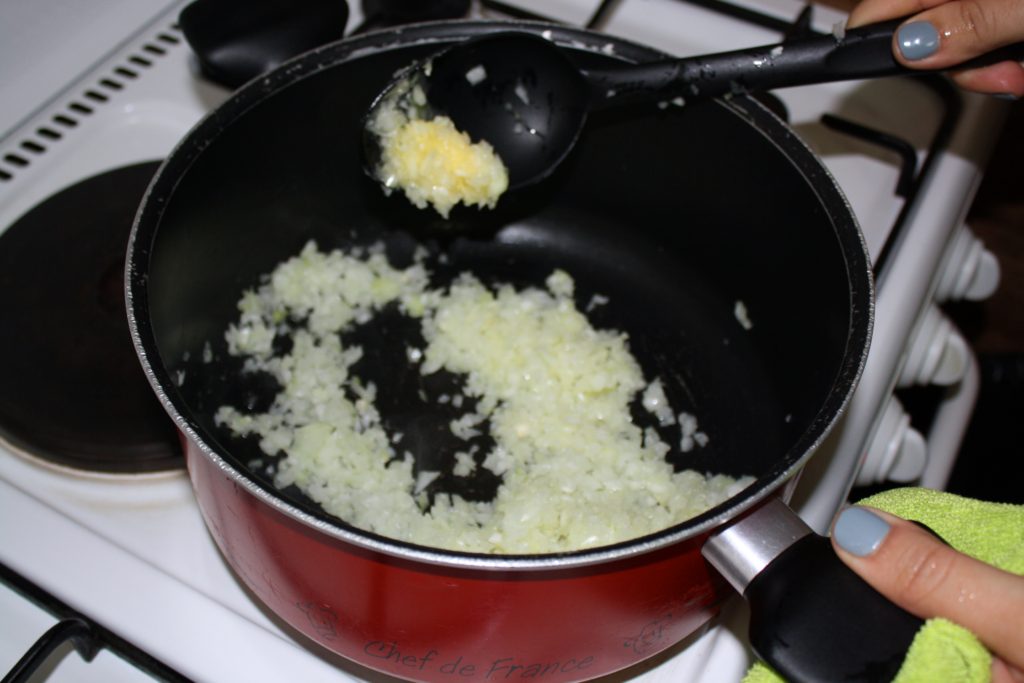 Add about a kilo of ground beef.
Add about a kilo of ground beef.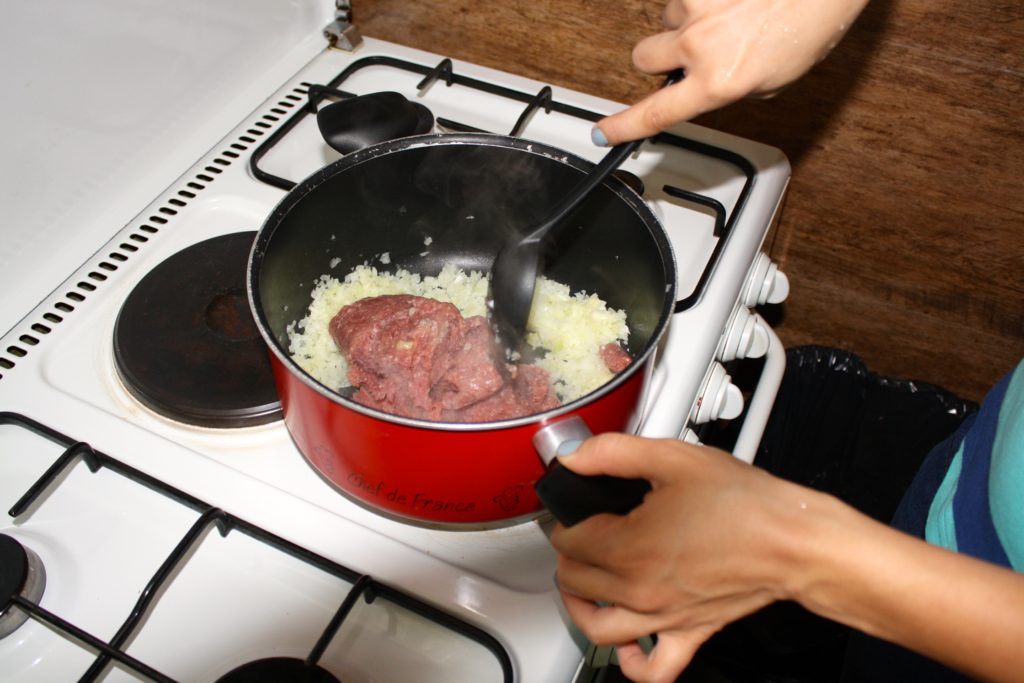 Salt and pepper to taste, along with paprika and 7 spice(or all spice).
Salt and pepper to taste, along with paprika and 7 spice(or all spice).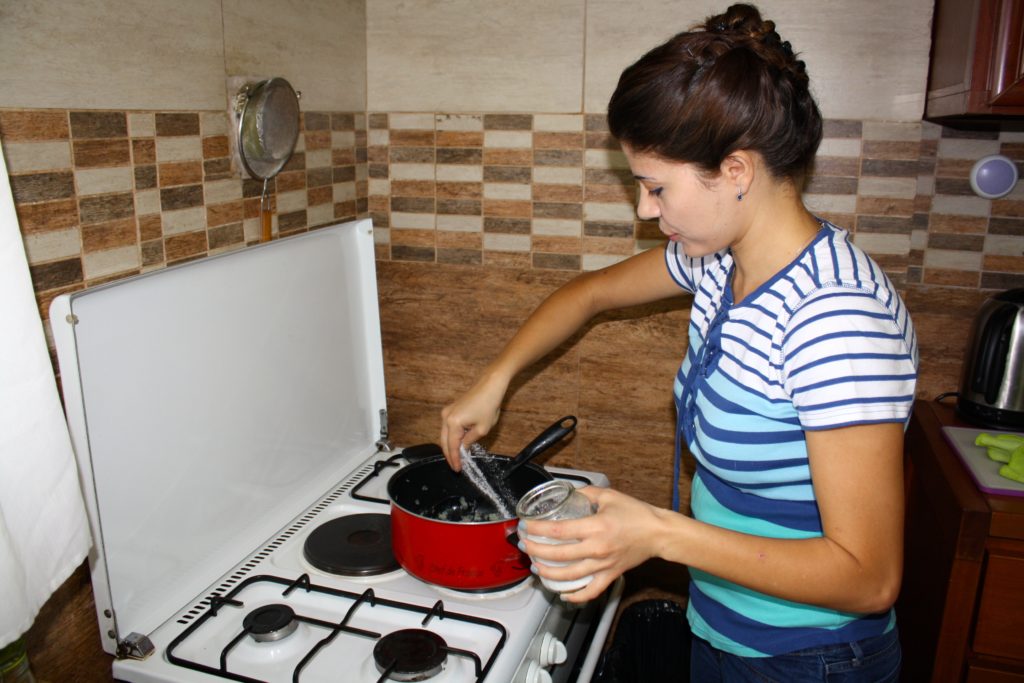
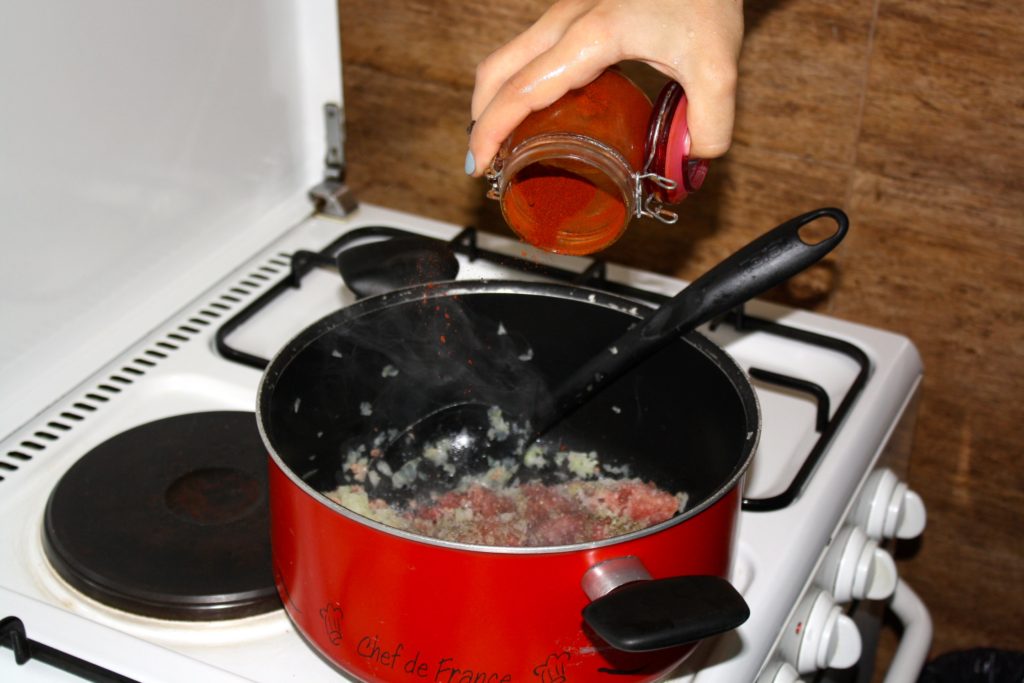 Chop up some walnuts and throw those in too.
Chop up some walnuts and throw those in too.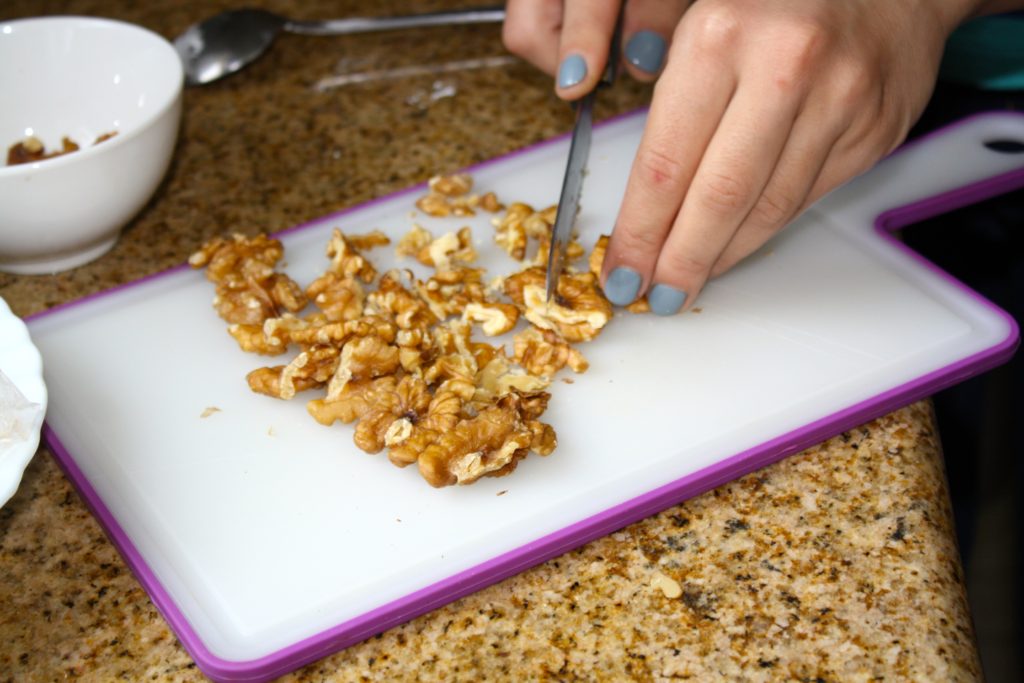
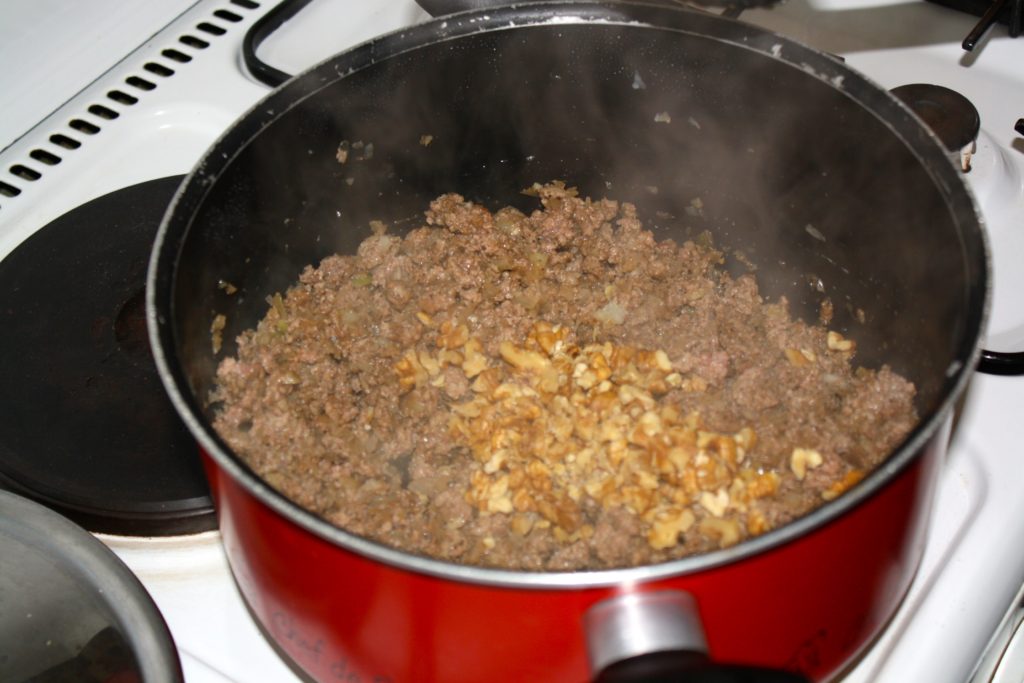 Add a splash of pomegranate molasses(or grenadine molasses-they’re the same thing with different names).
Add a splash of pomegranate molasses(or grenadine molasses-they’re the same thing with different names).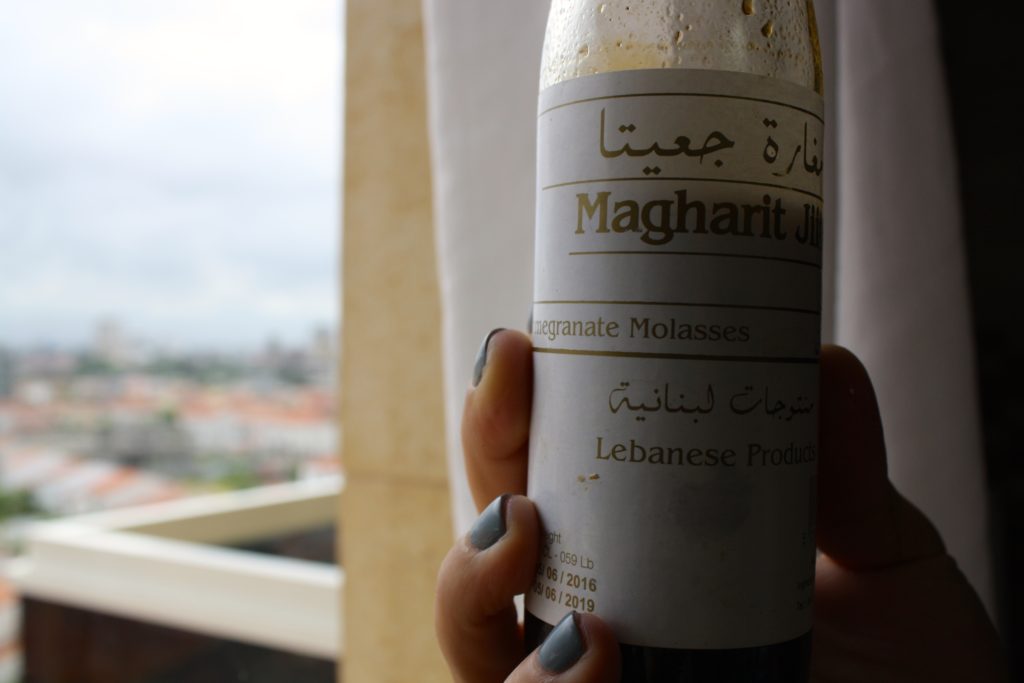 In a bowl mix corn starch and water. This will just be to dip your hands in so they don’t get sticky.
In a bowl mix corn starch and water. This will just be to dip your hands in so they don’t get sticky.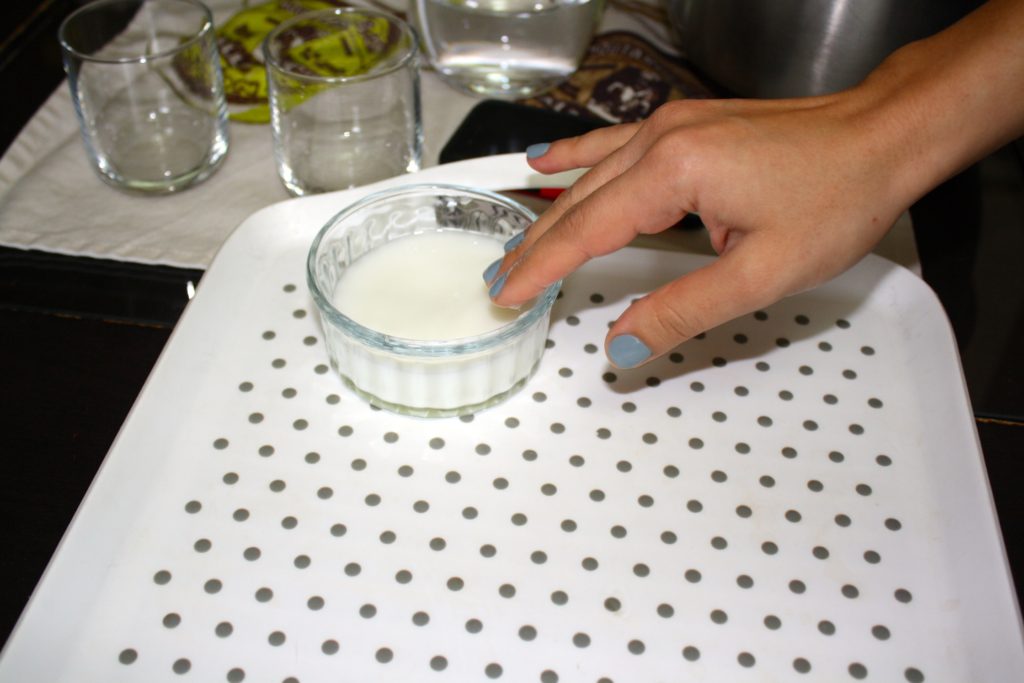 Your meat mixture is now complete. This will be the inside stuffing of your kebbeh.
Your meat mixture is now complete. This will be the inside stuffing of your kebbeh.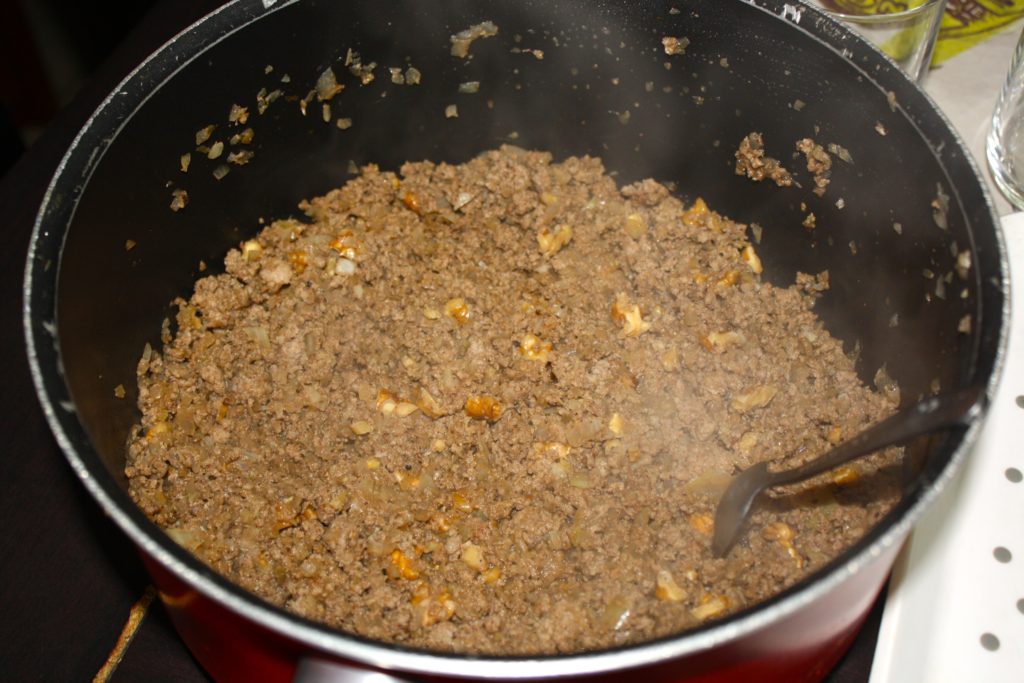 Go back to the first bowl we made over at the meat grinder. Take some of the bulgur and meat mixture and roll it into a ball, as if you were making meatballs.
Go back to the first bowl we made over at the meat grinder. Take some of the bulgur and meat mixture and roll it into a ball, as if you were making meatballs.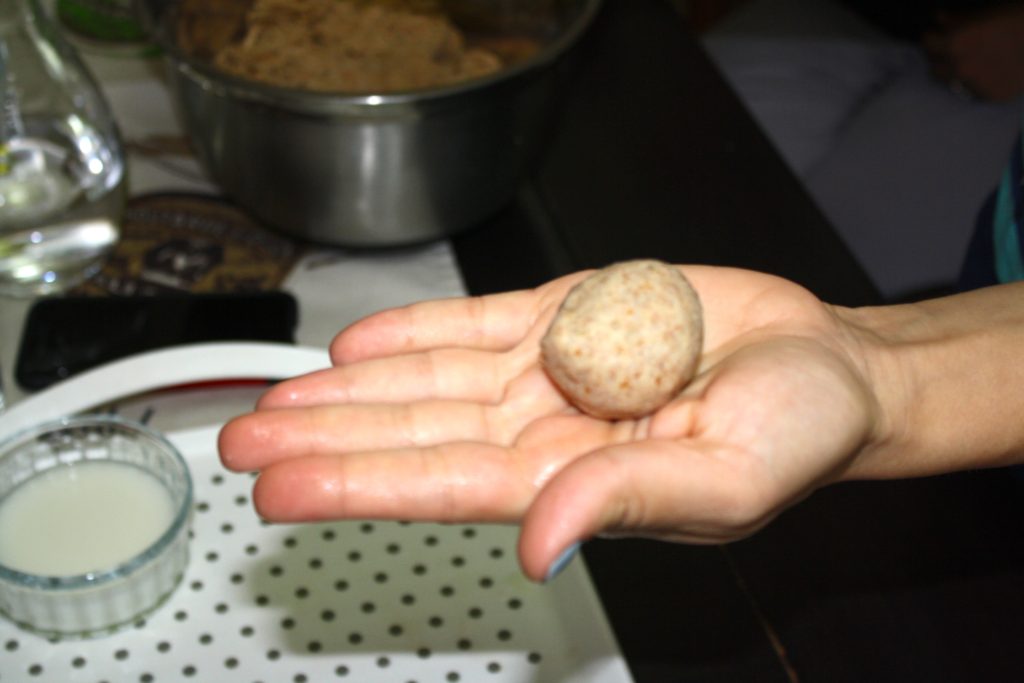 Then, using your pointer finger, press into the middle of the ball and work your way around the edges to hollow out the inside.
Then, using your pointer finger, press into the middle of the ball and work your way around the edges to hollow out the inside.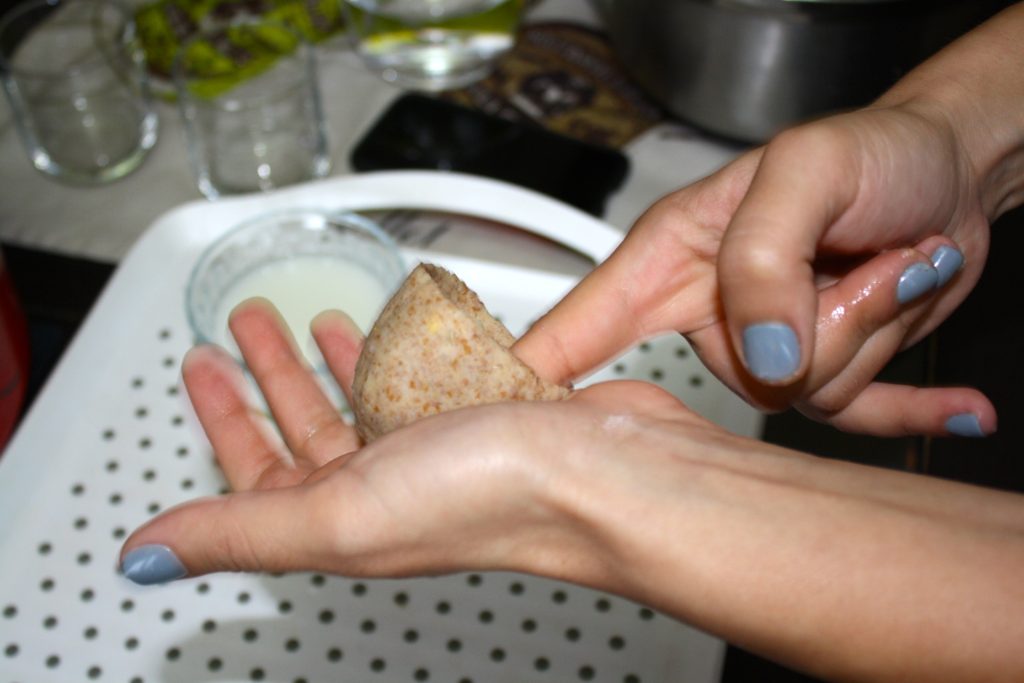 If you’re a professional, like Hadeel, yours will look like this.
If you’re a professional, like Hadeel, yours will look like this.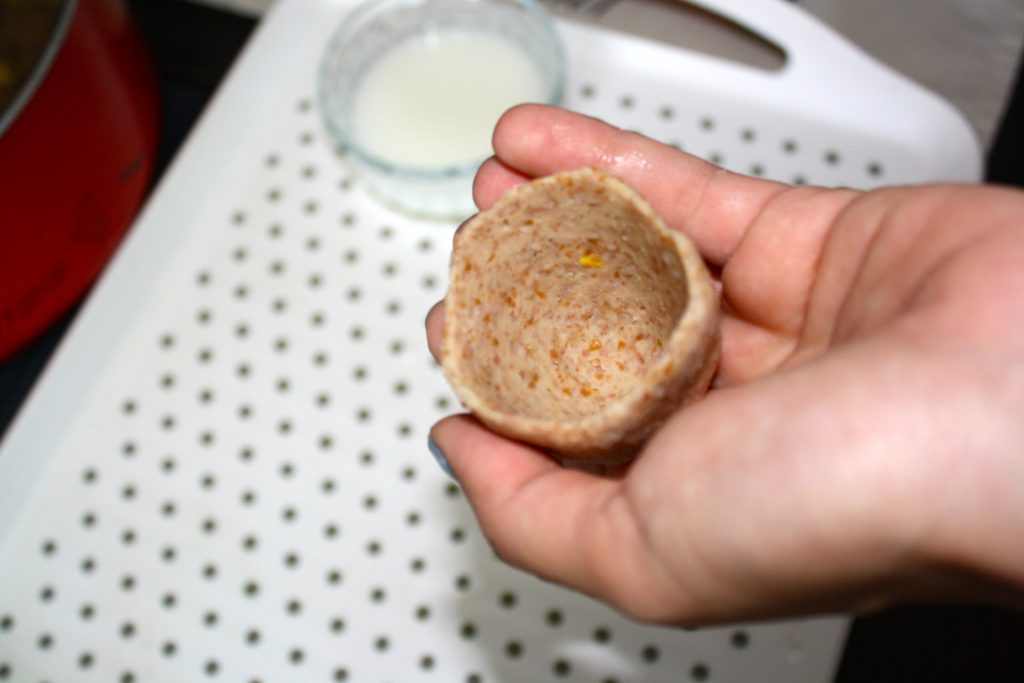 Now take the meat mixture and fill the inside, leaving room to seal it.
Now take the meat mixture and fill the inside, leaving room to seal it.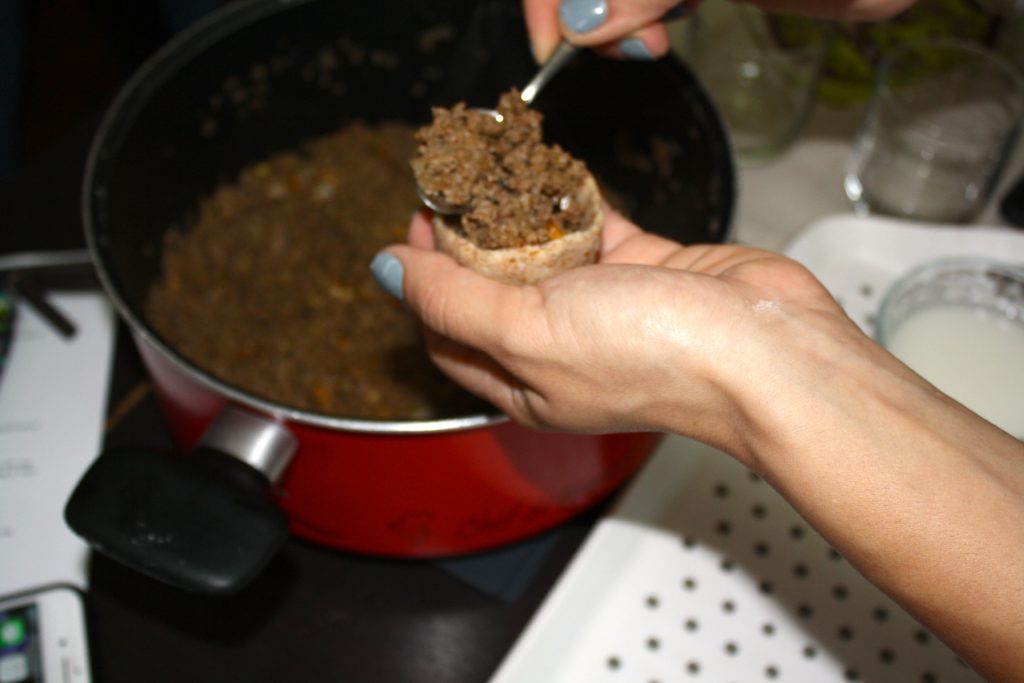 Close it up tight.
Close it up tight.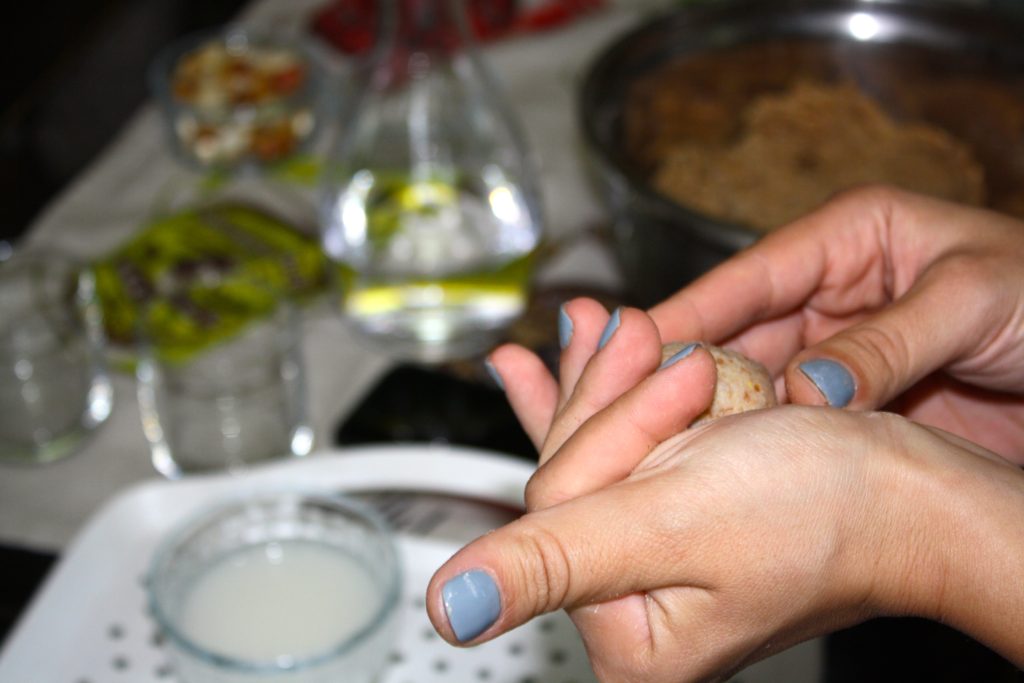 And again, if you’ve got skilled hands, yours will look like Hadeel’s.
And again, if you’ve got skilled hands, yours will look like Hadeel’s.
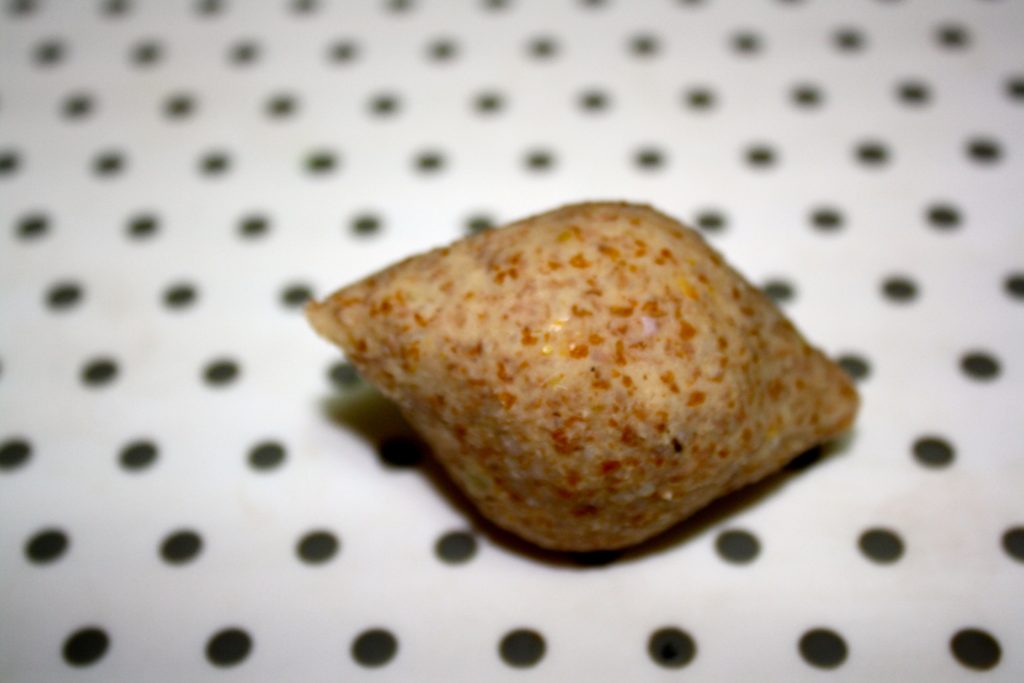 Now it was my turn to try. You’ll see from my face that I was nervous about my first kebbeh; meanwhile Hadeel was firing them off at rapid speed, with the perfection of someone who had done this many times before.
Now it was my turn to try. You’ll see from my face that I was nervous about my first kebbeh; meanwhile Hadeel was firing them off at rapid speed, with the perfection of someone who had done this many times before.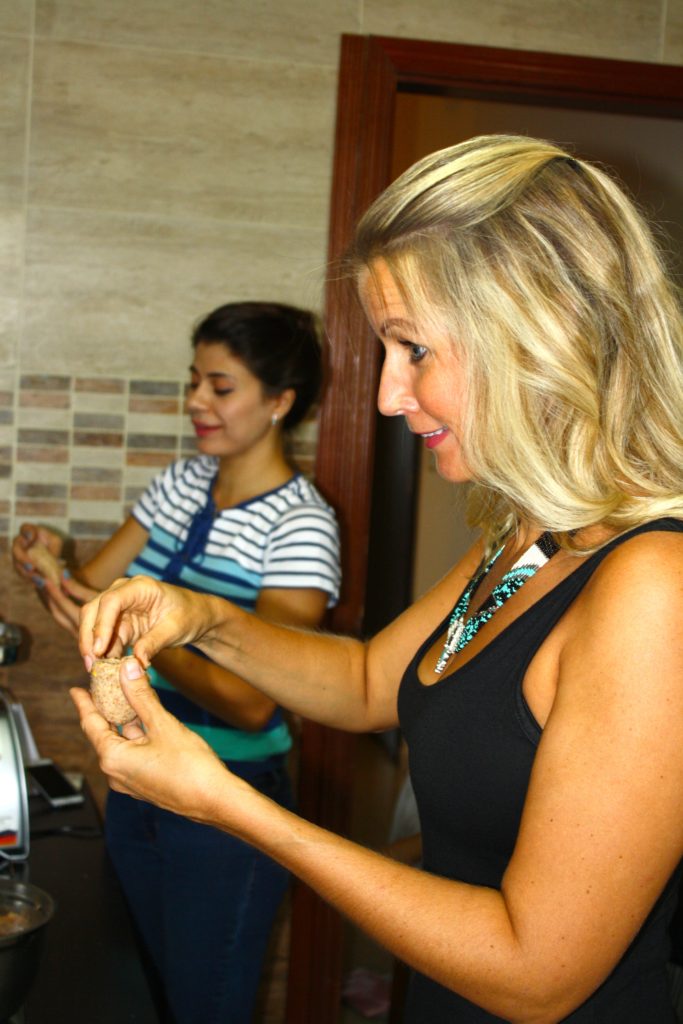 You can tell which ones were made by the professional, and which by her friends.
You can tell which ones were made by the professional, and which by her friends.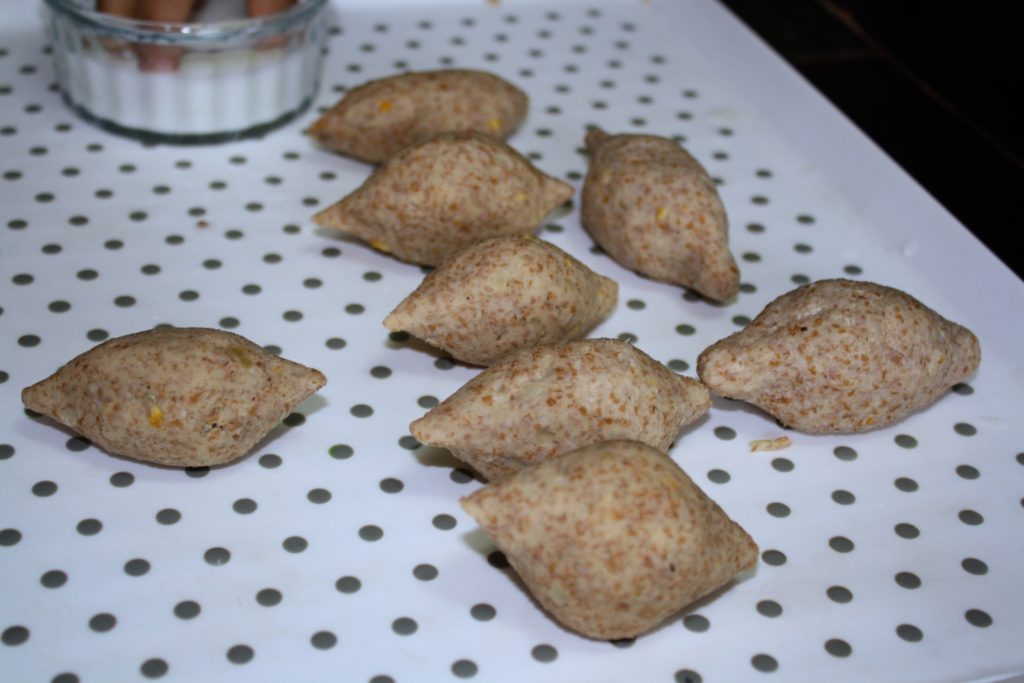 Into the deep fryer they went until they were golden brown.
Into the deep fryer they went until they were golden brown.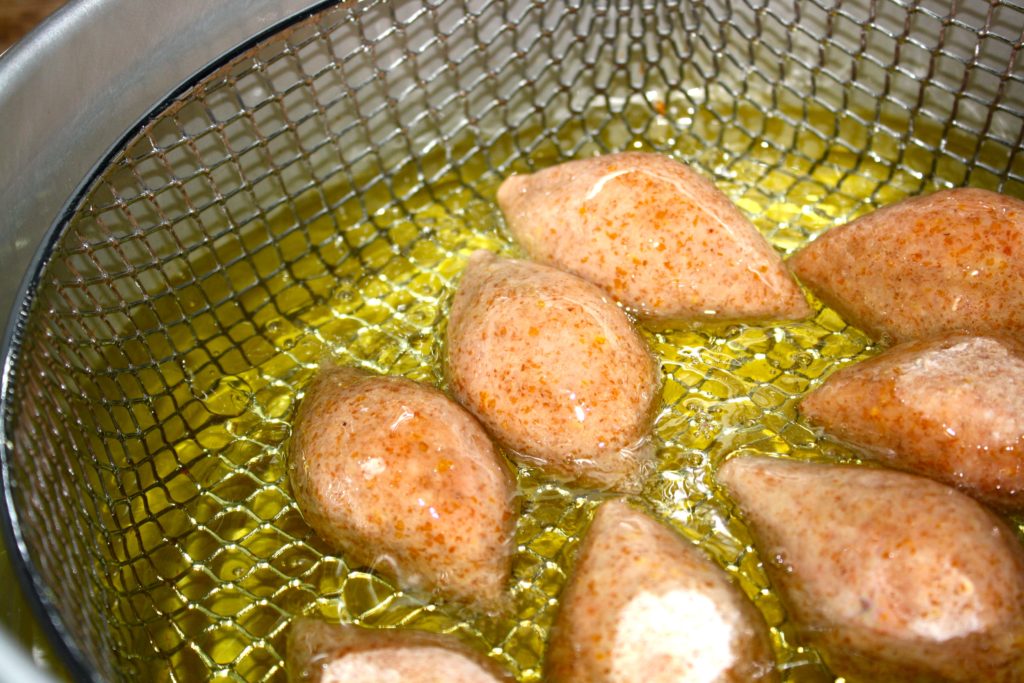 While the kebbeh were frying, Hadeel quickly chopped a mountain of parsley. Again, she had clearly done this before.
While the kebbeh were frying, Hadeel quickly chopped a mountain of parsley. Again, she had clearly done this before. It was tabbouleh time, and into the bowl went the parsley, bulgur, green onion, tomatoes, lemon juice, olive oil, salt, pepper and a pinch of citric acid to zest it up a bit.
It was tabbouleh time, and into the bowl went the parsley, bulgur, green onion, tomatoes, lemon juice, olive oil, salt, pepper and a pinch of citric acid to zest it up a bit.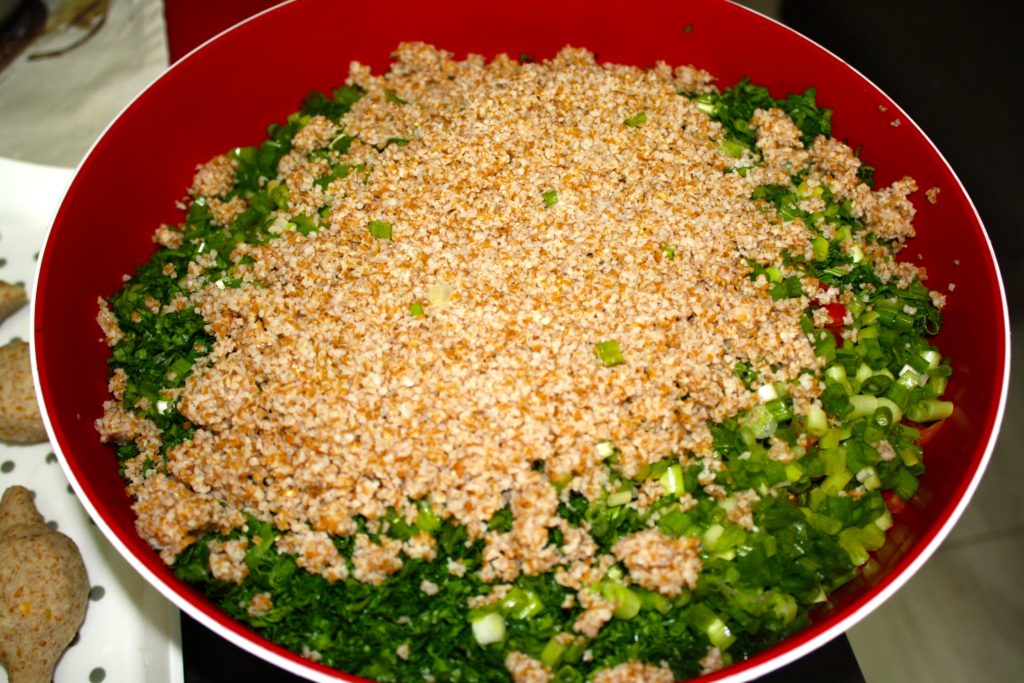 Mix it up and that’s all there is to it.
Mix it up and that’s all there is to it.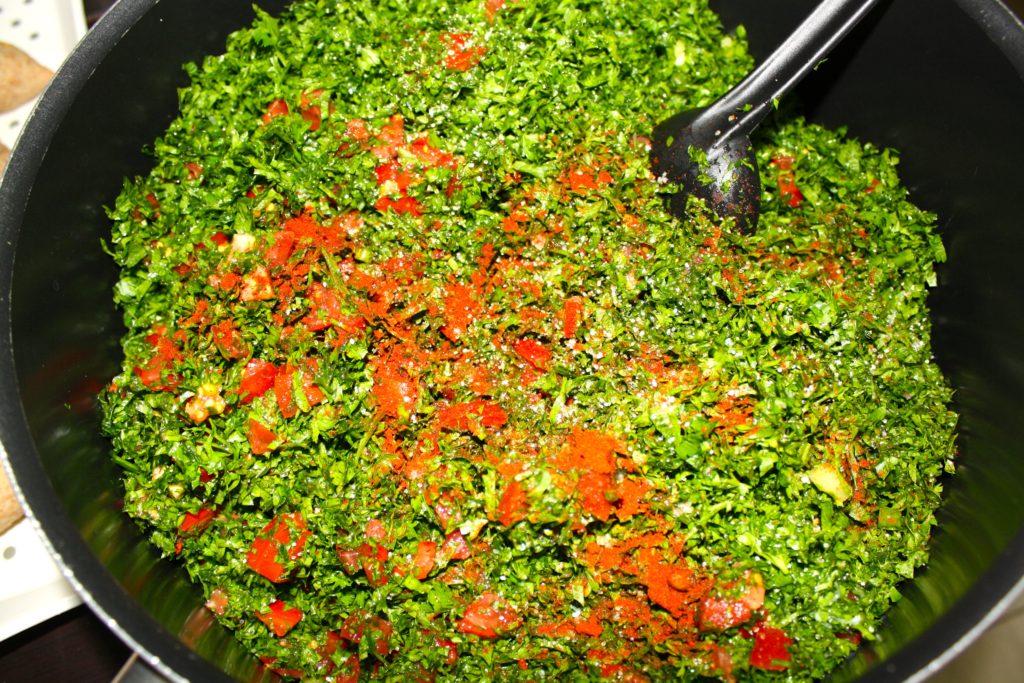 How good do these look?
How good do these look?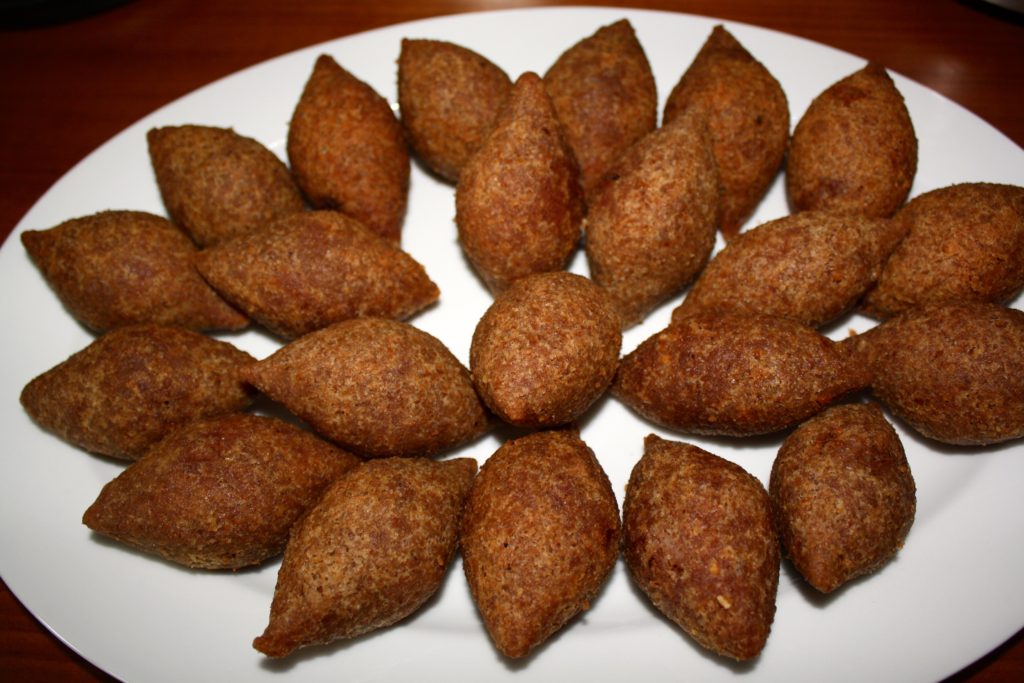 As I’ve now learned through my expat encounters, Arab hospitality never fails. Hadeel proved this to me yet again.
As I’ve now learned through my expat encounters, Arab hospitality never fails. Hadeel proved this to me yet again.  I started out by serving myself a modest portion, minding my manners, but I think I refilled twice because it was just SO good.
I started out by serving myself a modest portion, minding my manners, but I think I refilled twice because it was just SO good.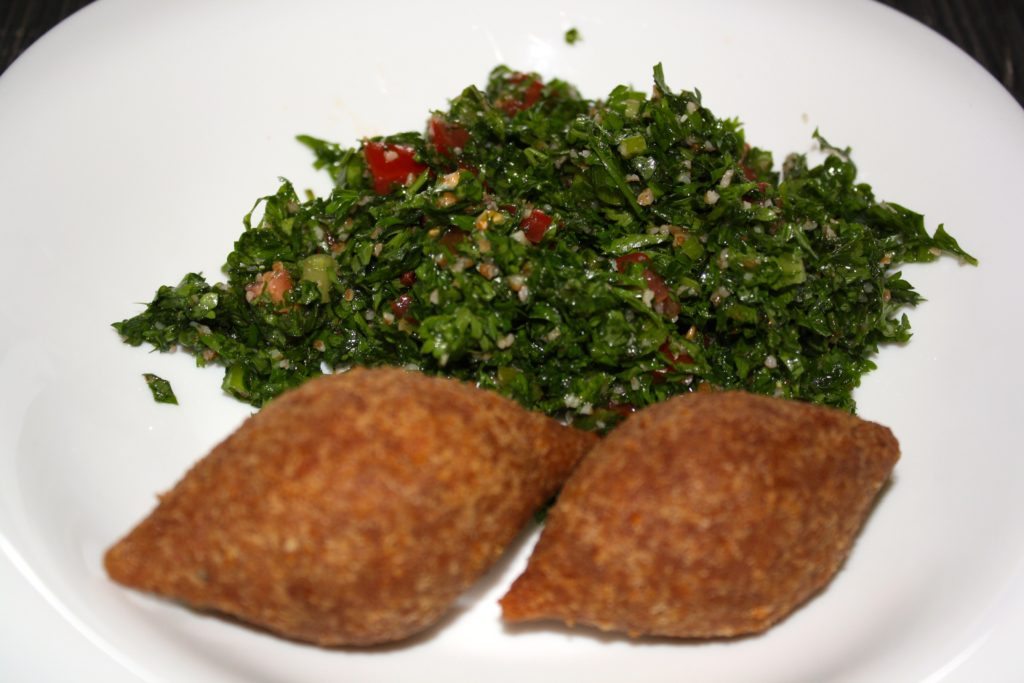 After we taste tested the fruits of our labour, the tea was brought out(of course!).
After we taste tested the fruits of our labour, the tea was brought out(of course!). 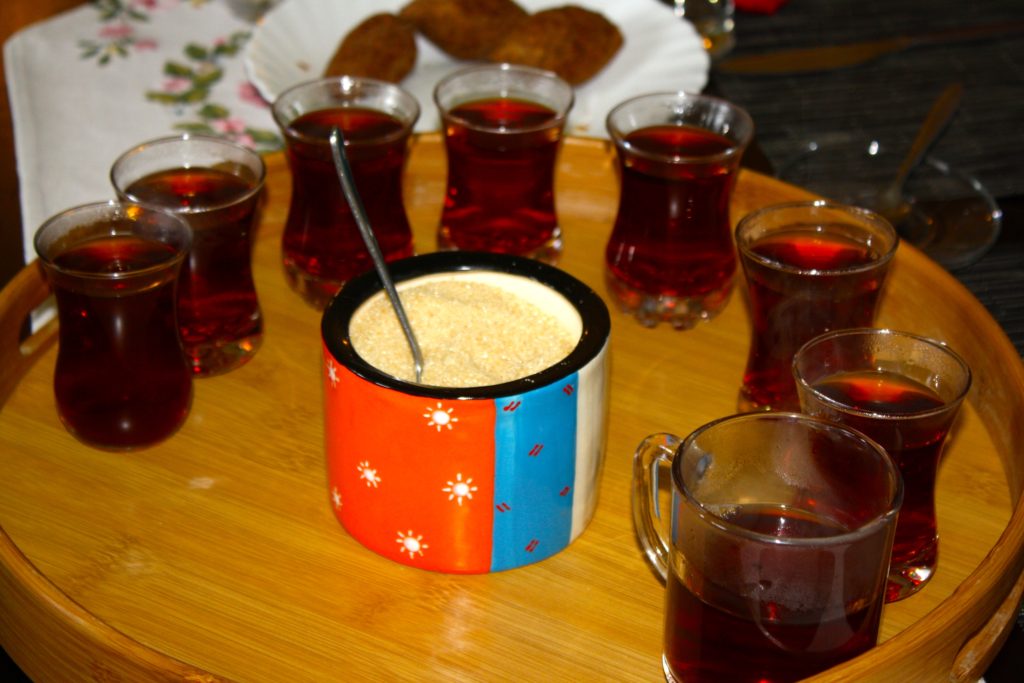 Hadeel had heard that I enjoy learning about many parts of Middle Eastern culture…sheesha included. And this was good news to her since she happen to have one of her own. What kind of Arab hospitality would she have if she didn’t offer me the full Syrian experience. 😉
Hadeel had heard that I enjoy learning about many parts of Middle Eastern culture…sheesha included. And this was good news to her since she happen to have one of her own. What kind of Arab hospitality would she have if she didn’t offer me the full Syrian experience. 😉
So out came the sheesha.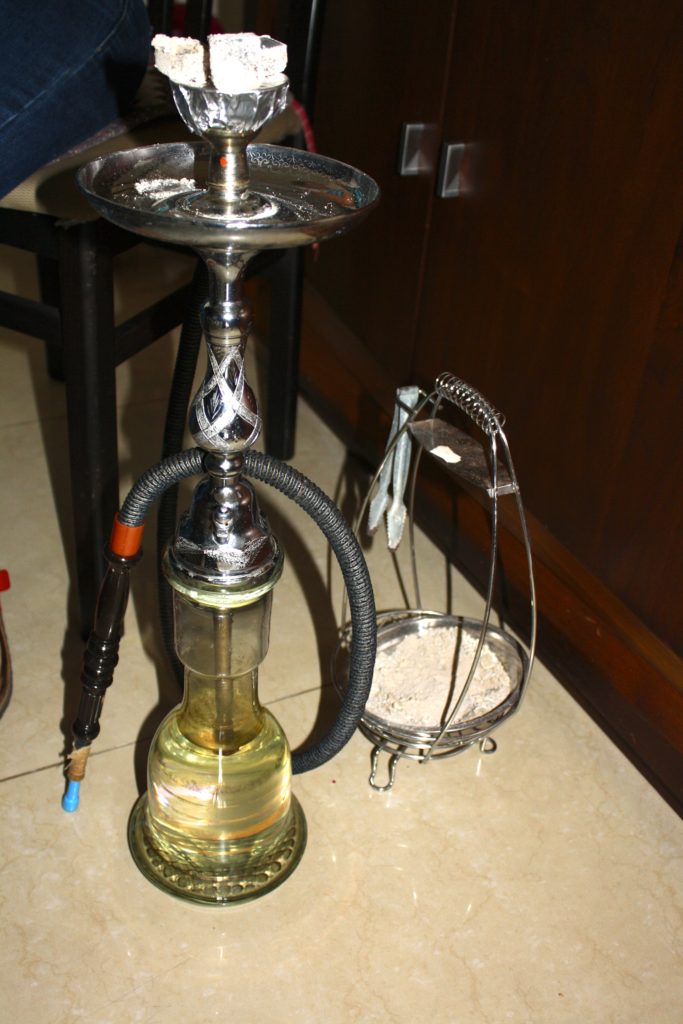 I’d come across my fair share of sheeshas in the Middle East, and there’s actually a dedicated person who takes care of it for you when you’re at a restaurant or lounge. Just like you have a waitress for your food and a bartender for your drinks, in the Middle East, there is someone who manages your sheesha, who I call the ‘sheesha guy’ but I’m sure there is a more official and polite term that I’m just not aware of.
I’d come across my fair share of sheeshas in the Middle East, and there’s actually a dedicated person who takes care of it for you when you’re at a restaurant or lounge. Just like you have a waitress for your food and a bartender for your drinks, in the Middle East, there is someone who manages your sheesha, who I call the ‘sheesha guy’ but I’m sure there is a more official and polite term that I’m just not aware of.
I’m not actually a smoker, but there’s something about this Middle Eastern water pipe and it’s fruity flavours that I always seem drawn to when I’m in that part of the world. I’ve never actually had sheesha at home, so I was looking forward to seeing up close how it all comes together.
You can see this little container had holes in the bottom. Then it is filled with molasses covered tobacco. There are all kinds of flavours and flavour combinations you can order if you’re out, and Hadeel’s supply rivaled any shisha menu I’d ever seen in a tea house.
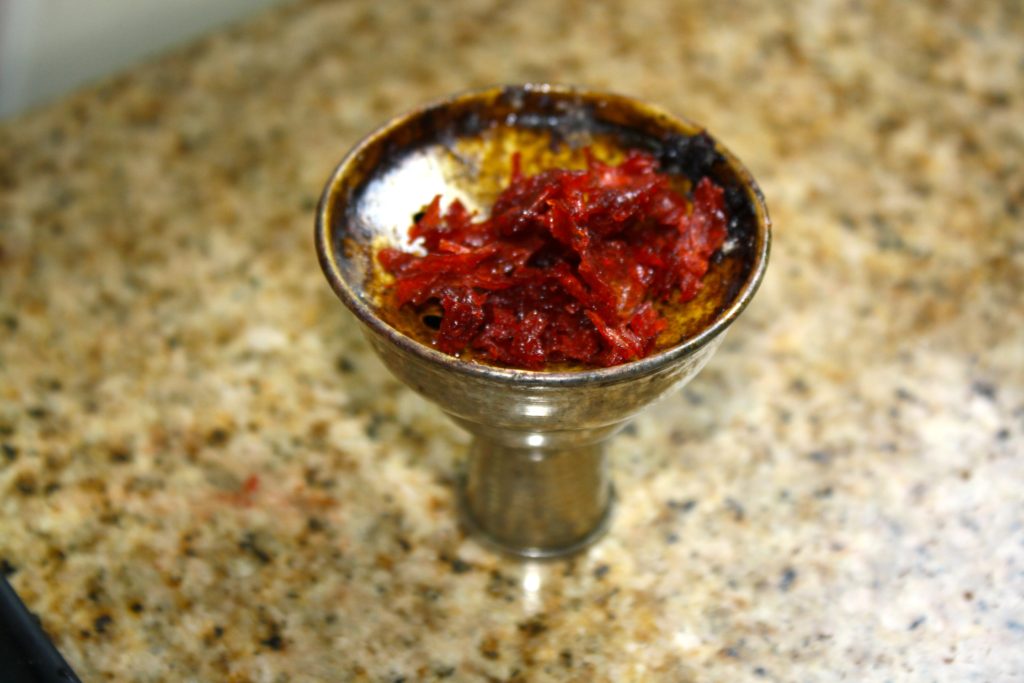 It’s then covered with foil, pricked and coals are put on to the foil.
It’s then covered with foil, pricked and coals are put on to the foil.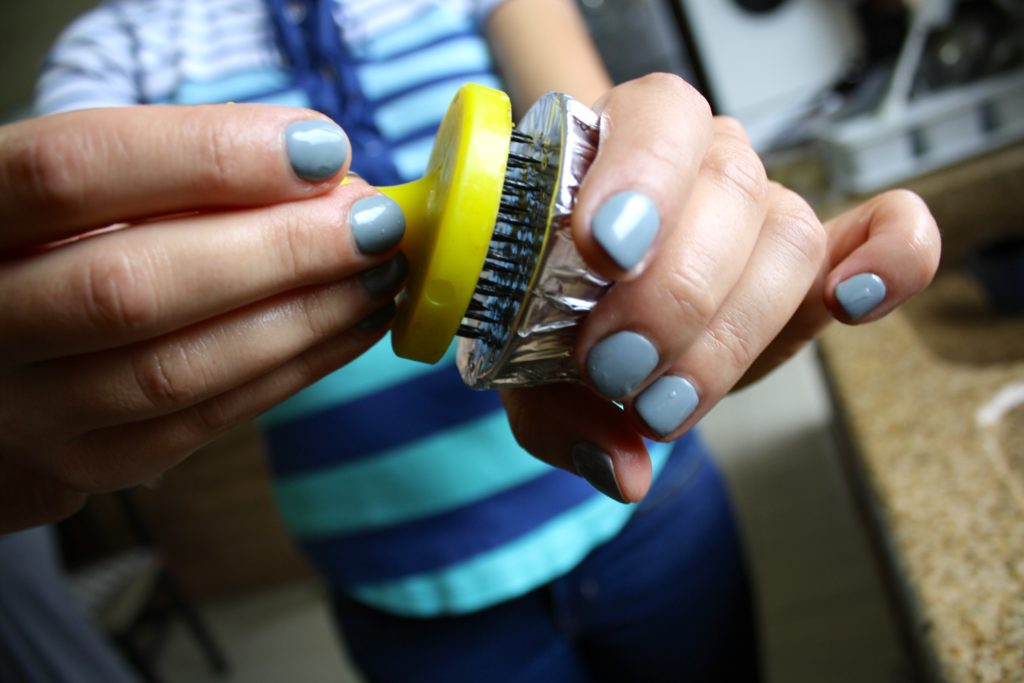 And there and you have it. A favourite Middle Eastern past time.
And there and you have it. A favourite Middle Eastern past time.
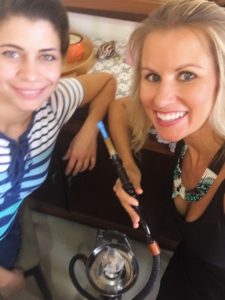 I’m always up for a cultural experience.
I’m always up for a cultural experience.
Thanks for the Syrian experience Hadeel. The food and the company were equally great!
If you’re in Pointe-Noire and you’d like to try kebbeh, tabbouleh, or other Syrian dishes, you can get in touch with Hadeel through her Facebook page, Hadeel’s Kitchen. Syrian food has now become a regularly ordered treat for my family!
Recipes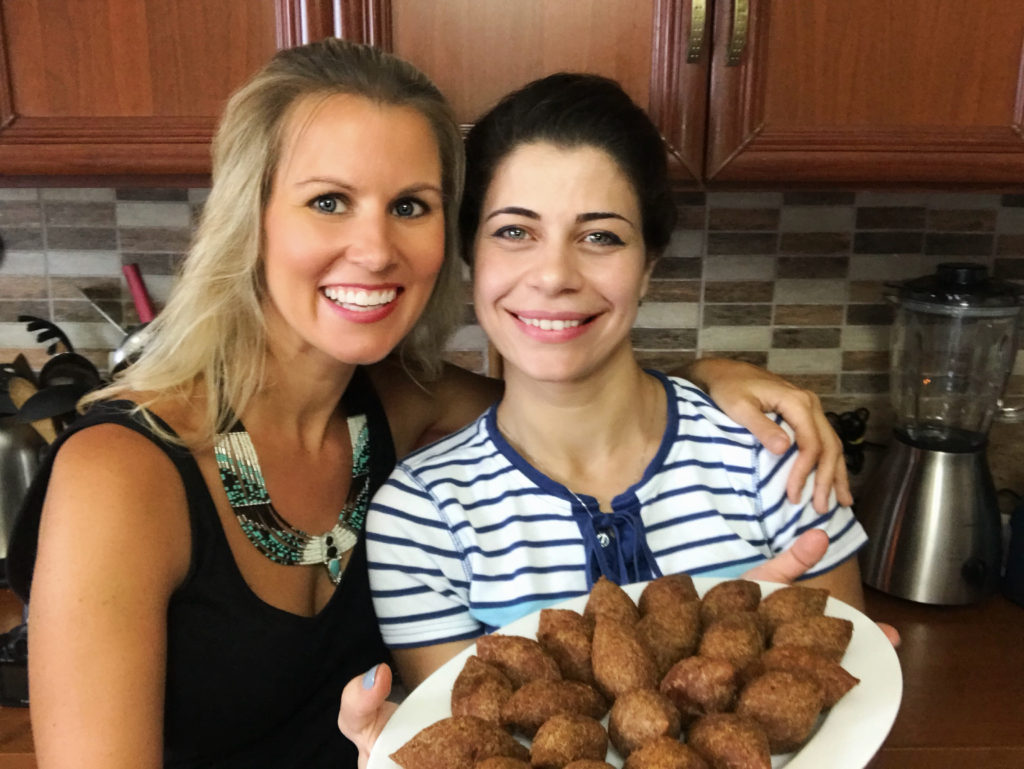 Kubbeh:
Kubbeh:
Ingredients
fine brown bulgar
finely ground lean beef
onion
cornstarch
salt and pepper
paprika and cumin
7 spice/all spice
orange peel (or lemon peel, marjoram or basil)
palmogranate molasses
walnuts
Directions
Outside of kebbeh
Rinse the bulgur 3 times.
For 1 kilo of bulgur, add 1.5 cups of water and throw in some orange peel and onions (or your flavour of choice). Leave it covered for at least an hour, giving it a stir every now and then.
After it has sat, grind the bulgur mixture.
Add 500 grams of lean ground beef and put it through the grinder again and set aside.
Filling
Mince onions and fry over medium heat with ghee butter. Add about a kilo of lean ground beef, plus paprika, all spice, and salt and pepper to take.
Mix and add pomegranate molasses and chopped walnuts.
Assembly
Take the ground bulgur/beef mixture and make into balls(meatball size). Then use your finger to hollow out the middle.
Fill with ground beef mixture and seal the kebbeh with a pointed end.
Deep fry until golden.
Tabbouleh
Ingredients
fine bulgur
parsley
tomatoes
green onion
lemon
olive oil
Directions
Finely chop parsley. Add diced tomatoes, green onion, lemon juice and olive oil to the bulgur. Salt to taste. If you prefer a zestier tabbouleh, add a pinch of citric acid.
Enjoy!

It’s so great to get new experience with new culture and test new food especially when you like it.
Good luck for Hadeel and her great family.